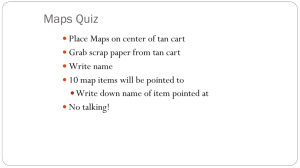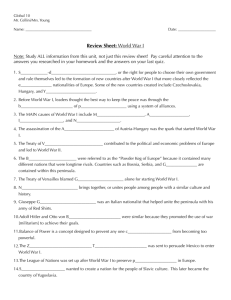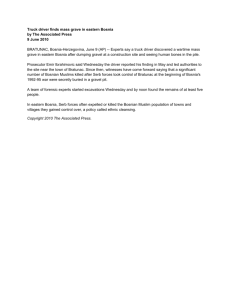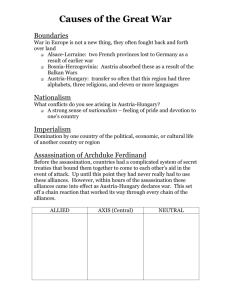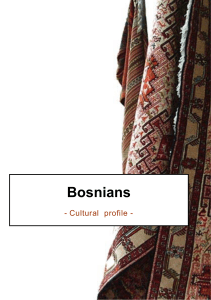Assignment Description - The Center for Middle Eastern Studies
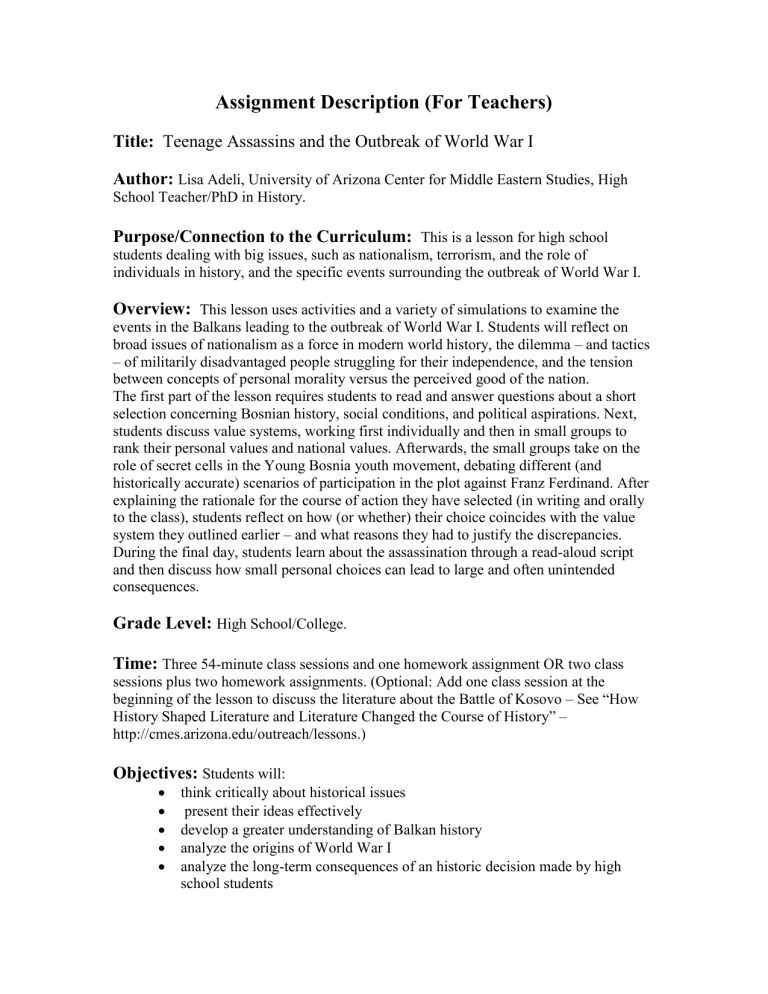
Assignment Description (For Teachers)
Title: Teenage Assassins and the Outbreak of World War I
Author:
Lisa Adeli, University of Arizona Center for Middle Eastern Studies, High
School Teacher/PhD in History.
Purpose/Connection to the Curriculum:
This is a lesson for high school students dealing with big issues, such as nationalism, terrorism, and the role of individuals in history, and the specific events surrounding the outbreak of World War I.
Overview:
This lesson uses activities and a variety of simulations to examine the events in the Balkans leading to the outbreak of World War I. Students will reflect on broad issues of nationalism as a force in modern world history, the dilemma – and tactics
– of militarily disadvantaged people struggling for their independence, and the tension between concepts of personal morality versus the perceived good of the nation.
The first part of the lesson requires students to read and answer questions about a short selection concerning Bosnian history, social conditions, and political aspirations. Next, students discuss value systems, working first individually and then in small groups to rank their personal values and national values. Afterwards, the small groups take on the role of secret cells in the Young Bosnia youth movement, debating different (and historically accurate) scenarios of participation in the plot against Franz Ferdinand. After explaining the rationale for the course of action they have selected (in writing and orally to the class), students reflect on how (or whether) their choice coincides with the value system they outlined earlier – and what reasons they had to justify the discrepancies.
During the final day, students learn about the assassination through a read-aloud script and then discuss how small personal choices can lead to large and often unintended consequences.
Grade Level:
High School/College.
Time:
Three 54-minute class sessions and one homework assignment OR two class sessions plus two homework assignments. (Optional: Add one class session at the beginning of the lesson to discuss the literature about the Battle of Kosovo – See “How
History Shaped Literature and Literature Changed the Course of History” – http://cmes.arizona.edu/outreach/lessons.)
Objectives:
Students will:
think critically about historical issues
present their ideas effectively
develop a greater understanding of Balkan history
analyze the origins of World War I
analyze the long-term consequences of an historic decision made by high school students
Targeted Skills - Based on Arizona State Standards:
High School Social Studies: Geography Strand:
Concept 2: Places and Regions. PO 1 – Identify the characteristics that define a region – with specific reference to human processes such as religion and political organization. PO 4 – Analyze the differing political, religious, economic, demographic, and historical ways of viewing places and regions.
Concept 6: Geographic Applications. PO 3 – Analyze how geography influences historical events and movements.
High School Social Studies: World History Strand:
Concept 7: Age of Imperialism. PO 5 – Analyze the responses to imperialism by people under colonial rule.
Concept 8: World at War. PO 1 – Examine the Causes of World War I, a-rise of nationalism in Europe, c-rise of ethnic and ideological conflicts – the Balkans,
Austria-Hungary, the decline of the Ottoman Empire.
Concept 9: Contemporary World. PO 2 – Examine the roots of terrorism.
High School Language Arts:
Various writing and reading skills.
Suggested Procedures
Assignment 1 (Homework or Day 1):
Required: Handouts or computer access to the short reading and review questions (Document #2 – Young Bosnia - reading)
Students, working individually or in groups of 3 (see below), will read about the lives and aspirations of Bosnian young people on the eve of World War I and answer (in writing) the questions that follow. Note: Students must complete this part before they can do the other activities.
- Assignment 2 (Day 1 or 2):
Required: Handouts of Documents #3 (Young Bosnia – values) and
Document #4 (Young Bosnia – decision).
- Students are assigned to work in groups of 3. They must each have an individual sheet of paper (with one name on it) and a group sheet (with all 3 names on it). At the end, collect all the papers and staple them together to use in grading.
- Students work individually to do the short survey of values on their individual sheet of paper. Then, they discuss it with their group, putting the consensus results on the group sheet.
- Students read over the scenarios individually and decide their preferred course of action.
They write a paragraph on their individual sheets explaining their reasons for their choice. Then, they make a decision with the other students in their group. Since the group represents a secret cell in Young Bosnia, they have to come to a consensus. Agreeing to disagree is not an option since the group has to act as a whole. Note: The arguments can become heated!) At the end, they need to write a summary of their conclusion. When all groups have decided, do a brief oral survey to let the class see which course of action the others have chosen.
- Assignment 3 (Day 2 or 3):
Required: A classroom set of the read-aloud script from the lesson
(Document #5), 8 informal, hand-lettered signs (can be photocopy paper with the words printed with markers) with the following written on them (Note: write the country or alliance name in big letters, the student role number in smaller letters.):
(a) Great Britain (Student #1), (b) Germany (Student #2), (c) Russia (Student #3),
(d) France (Student #4), (e) Italy (Student #5), (f) Austria-Hungary (Student #6), (g)
Triple Entente (Student #7), (h) Triple Alliance (Student #8). This lesson is a
“reenactment” and discussion of the organization of the alliance system and the Sarajevo assassination. It’s an easy way to involve kids who don’t normally participate or prepare well for class. And since it’s a high interest story, they can get very involved (so you may wish to warn neighboring classes not to be alarmed by over-boisterous participants!).
- Homework: Have the students write a reflection paper on any of the topics that you have discussed. You can assign the topic or leave it up to them. Or you can have them write the paper as a work of historical fiction, an eyewitness observer’s description of events.
Assessing Student Learning
20%: Answers to questions on the reading
20%: The “packet” from the group work.
30%: Class participation.
30%: Reflection paper.
Extending the Lesson:
Use some of the primary documents from the month between the assassination of Franz
Ferdinand and the Austrian declaration of war on Serbia. You can find them at: http://www.firstworldwar.com/source/1914.htm
. Analyze the process by which an incident in a remote part of Europe turned into the outbreak of a world war.
